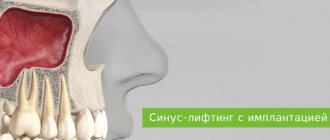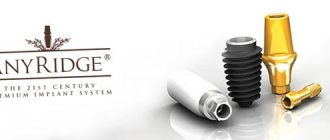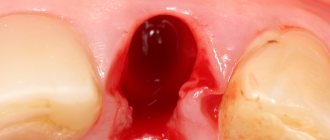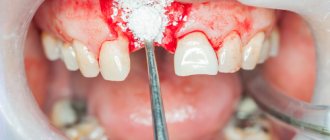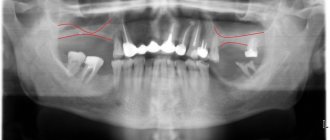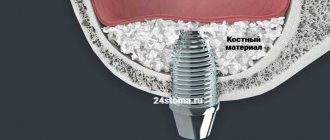Dentist Studio Dent has successfully mastered a new technology for bone tissue augmentation. This method is called "Sinus lift".
Sinus lift surgery must be resorted to in cases where the patient has insufficient bone tissue for implantation of artificial teeth. Unfortunately, this happens quite often.
Statistics show that in seventy percent of cases where implantation is impossible, the cause is atrophy of the gum bone tissue. In simple words, the gums have simply decreased greatly in size. This is especially often observed in patients whose oral cavity does not have a single tooth preserved.
The absence of teeth with a simultaneous reduction in the size of the gums leads not only to deformation of the oval of the face. Much worse is that in such a situation the chewing function is completely lost, and this leads to gastric and intestinal diseases. It is impossible to fix removable dentures on reduced gums. Implantation is needed, but this cannot be done without bone tissue augmentation.
Fortunately, medical science has created sinus lift technology, which allows us to get out of such a deplorable situation. However, everything does not look as happy as we would like. Like any other dental operation, sinus lift has its contraindications.
The essence of sinus lift technology
Sinus lift technology is an operation to build up bone tissue in the upper jaw when it is insufficient for implantation of artificial teeth. Let’s make a reservation right away that there is a technology for building up bone tissue in the lower jaw, but this article will not discuss it.
The sinus lift technology was first successfully mastered by American dentists back in 1976. This operation is very complex and requires the highest qualifications of the surgeon.
During a sinus lift, the surgeon makes a thin hole in the gum and jawbone. Through this hole, he displaces the bottom of the maxillary sinus and fills the resulting void with synthetic bone tissue. Sinus lift surgery can be open, closed or balloon.
What implants are used after bone grafting?
Are there “special implants” that are recommended in cases of bone grafting? Both with bone grafting and without bone grafting, it is necessary to use implants only from good, proven manufacturers, those that have a good clinical base. For example – Straumann, Nobel, Ankylos, Xive, Astra Tech.
There are a number of other implant systems that give good results. But at the German Implant Center we use only the best implant systems, only premium ones.
Open sinus lift
An open sinus lift is done in four stages and is a very complex operation.
First, the surgeon makes a thin hole in the gum and the bone under it, while he achieves a slight separation of the upper jaw bone from the gum.
At the second stage, using special surgical instruments, the doctor slightly lifts the bottom of the nasal (maxillary) sinus.
The essence of the third stage of the operation is to fill the vacated space with artificial bone material. This is done through the hole that the surgeon originally made.
During the final fourth stage, the surgeon returns the detached part of the bone tissue to its place and sutures the wound.
This type of operation is recommended for significant lack of bone tissue in the lateral parts of the upper jaw.
Formation of bone tissue immediately after tooth extraction
In complex tooth extractions, the socket often has a particularly large cavity. This is due to the size of the tooth being removed, its position in the jaw, the structure and branching of the roots. Experienced dental surgeons can predict the outcome of the operation in advance and offer the patient tooth socket preservation.
Preservation of the socket of an extracted tooth is aimed at quickly restoring destroyed bone tissue and preserving the natural contours of the gums. The procedure takes place in several stages and involves the use of osteogenic materials. The surgeon immediately after extracting the tooth:
- treat the wound with antiseptic compounds;
- make sure there is sufficient bleeding;
- install a membrane to protect the vestibular wall;
- mixes blood with bone materials that are planned to be implanted into the socket;
- fill the socket cavity with the prepared granular osteoinductive composition;
- will apply collagen fleece to protect the socket and bone material;
- Pull and secure the edges with sutures.
Complete healing of the hole occurs in 3-4 weeks, and after 4-5 months doctors allow tooth implantation.
Preservation of the hole: indications
Preservation of the socket during tooth extraction is recommended for all patients planning dental implantation. Bone material will restore the lost volume and preserve the natural contours of the alveolar process.
This will make it easier for the doctor to carry out the implantation operation and will reduce time and financial costs for the patient.
Closed sinus lift
This method of sinus lift is also called soft. This operation is done when the patient's bone height is 7-8 mm. The surgeon makes a cylindrical hole in the area of the upper jaw bone where the implant will be installed. After this, using an osteotome, the maxillary sinus is shifted. Synthetic bone tissue in the form of very small plastic granules is injected into the resulting cavity. In this way, the bottom of the sinus is fixed in a slightly elevated position, and the implant is subsequently installed in the previously made hole.
Balloon sinus lift
Balloon sinus lift is used for those patients whose bone height is 3-4 mm. The advantage of this method is that the implant is installed immediately after the sinus lift is completed.
The essence of this method is very similar to the technology of closed sinus lift. Raising the floor of the maxillary sinus and filling the space with synthetic dental tissue is done in the same way as with a closed sinus lift. The same surgical instruments are used.
The difference is that a thin catheter with a balloon is inserted under the mucous membrane, into which a special radiopaque liquid is then injected. The balloon begins to expand and thereby delicately peel off the mucous membrane. This method allows the implant to be implanted immediately after the sinus lift is completed.
Materials used
Installing an implant allows you to restore the root system, but this requires a sufficiently dense base that can fix the artificial pin, which necessitates the use of osteoinductive agents that stimulate regeneration. Double-layer collagen membranes treated with a restorative drug allow you to restore the natural blood circulation cycle. The material used for the manufacture of membranes includes resorbable and non-resorbable elements that differ in functional properties. During directed regeneration, bioactive compounds and distracting compounds are also used - to obtain the optimal combination, doctors combine various elements that help accelerate integration.
Contraindications
A patient may be denied a sinus lift if he or she has the following problems:
- sinusitis;
- polyps;
- chronic runny nose:
- excessive number of septa in the maxillary sinuses:
- poor bone condition.
In addition, if surgery was performed in the area of the maxillary sinuses, then sinus lifting is also contraindicated. You should also know that if you are a heavy smoker and are unable to abstain from this addiction until postoperative injuries are completely healed, then this procedure is contraindicated for you.
Preparing for surgery
Like any other operation, sinus lift requires patient preparation. The surgeon will never decide to operate until he is sure that the patient’s maxillary sinuses are normal. To do this, a detailed examination is carried out with mandatory x-rays. If there is the slightest deviation from the norm, surgery cannot be performed.
Also, in preparation for a sinus lift, a complete examination of the patient’s body condition is carried out.
Perhaps it wouldn’t hurt to give some good advice here. If the clinic where you are planning to go for a sinus lift does not have a 3D computed tomograph, then it is better to look for a more reputable clinic that has this expensive medical device. The fact is that only it allows you to get a complete picture of the state of a person’s internal organs.
Studio Dent purchased a computer tomograph for 6 million rubles, and this was done not for the sake of advertising or profit, but for the sake of obtaining impeccably accurate examination results.
Also, in preparation for surgery, the patient may be prescribed a course of medication. Most often this is taking antibiotics to prevent bacterial infections. Steroids may also be prescribed to promote rapid wound healing and reduce the likelihood of inflammation.
Sequence of sinus lift
At the first stage of the operation, the surgeon makes an incision in the oral cavity from the distal tubercle to the canine area. It is necessary to gain access to the lateral wall of the sinus and to remove the mucoperiosteal flap.
After this, a cut of the cortical layer is made using a spherical bur. This process involves abundant irrigation.
The surgeon then creates small perforation points in the bone along the upper edge of the cut and makes a hole to inject synthetic bone material. This is an extremely delicate job, only experienced surgeons can do it.
The next stage of sinus lift is no less difficult. The surgeon peels off the mucous membrane and moves the bottom of the maxillary sinuses upward.
After this, the final stage of the operation begins. The surgeon pumps bone tissue into the resulting cavity and sutures the wounds.
This operation can only be performed by experienced oral surgeons and no one else.
When can you do without bone grafting?
You can always do without bone grafting when you can install an implant of the required diameter and required length into the remaining bone.
And, in fact, you shouldn’t do bone grafting just to assert yourself. Some doctors suffer from this, trying to prove to themselves or someone else how they can do bone grafting.
But, as they say, the best bone grafting is the one we don’t do: if the patient can be rehabilitated without bone grafting, then it’s better to do just that. Since volume can be added with soft tissues, connective tissue can be transplanted - a graft, or drugs can be added to replace the volume of soft tissues - and achieve an excellent result!
Possible postoperative complications
After a sinus lift, the following problems may arise:
- acute chronic sinusitis;
- swelling of the palate;
- sinusitis;
- increased body temperature;
- rupture of the mucous membrane inside the maxillary sinus or its perforation;
- chronic runny nose;
- bleeding from the nose and at the operation site.
All these troubles can occur due to insufficient qualifications of the doctor and the use of low-quality materials and instruments.
Indications
The operation allows you to increase the “necessary” volume for high-quality classical implantation, helps restore the functions of the jaw, and returns the gums to an attractive appearance.
The bone is built up “with reserve”, since after the operation the surface layers will be supplied with a small amount of oxygen due to their lower blood circulation. Therefore, the volume of inevitable tissue resorption is calculated.
In addition to implantation, indications for NRC are:
- rapid restoration of physiological parameters after tooth extraction;
- congenital or acquired defects of the bone around the teeth;
- prevention of tooth displacement, loosening, and loss due to periodontal tissue diseases.
Why does atrophy occur?
Disadvantages of sinus lift
A sinus lift is the only way to build bone in the upper jaw, but let's start with the disadvantages of this technology.
In addition to the above-mentioned possible postoperative complications, this operation may lead to sinking of the implant with subsequent damage to the maxillary sinus. This inevitably causes inflammatory processes in the sinuses.
Undoubtedly, the disadvantages of the technology include the too long period of postoperative rehabilitation. Sometimes it drags on for several months.
During the rehabilitation period, even coughing or sneezing can cause unwanted pressure on the synthetic bone tissue or implant and dislodge them. There are cases where patients' implants fell out when they sneezed.
During rehabilitation, except for special nutrition, which, frankly, no one likes, you cannot engage in physical exercise, fly on airplanes and... drink drinks through a straw.
Advantages of sinus lift
Sinus lifting with subsequent implantation gives incomparably better results compared to wearing removable dentures. In addition, it is often only possible to implant artificial teeth through a sinus lift.
This operation allows you to restore the lost volume of bone tissue of the upper jaw.
Rehabilitation after a closed sinus lift is not that long.
Sinus lifting in combination with implantation allows you to restore chewing function to normal, which removable dentures cannot provide.
Can it be done simultaneously with implantation?
Two operations are combined into one if the following conditions are met:
- the shape of the defect allows you to correctly install the artificial root in any of the planes;
- when installed, the implant is located within the bone contour (does not go beyond the tangent drawn to the bone line);
- eliminate a horizontal (not vertical) defect.
The implanted implant can become a barrier to the growth of blood vessels and inhibit the formation of new bone. If the implant protrudes beyond the contour of the bone tissue, the risk of developing fibrous tissue with inclusions of the implanted material cannot be ruled out.
Basal implantation
Agree, not every patient who experiences a decrease in the volume of bone tissue in the upper jaw can decide to undergo a sinus lift. Fortunately, there are at least two options for indecisive patients. This is to install mini-implants or do basal implantation.
The implantation of mini-implants is done in exactly the same way as conventional implants, and therefore we will not talk about it here.
Basal implantation allows the implantation of implants for dystrophy of the bone tissue of the upper jaw. This method was invented three decades ago, but is only truly mastered in our time. Such a long delay is due to the fact that at the time of the discovery of the technology there was simply no technical opportunity to bring it to life. Today such an opportunity exists because the appropriate materials and tools have been created.
Basal implants resemble an inverted “T” in appearance. They are implanted into the jawbone not directly, but from the side. This means that the load during chewing acts not on compression, but on the bending of the jaw bone. This eliminates further reduction in the volume of jaw bone tissue
The advantage of basal implantation is that implants can be implanted immediately after removing the remaining roots or completely damaged teeth. In addition, it is possible to install permanent dentures on the implants in just two or three days. However, the most important thing about basal implantation is that after a maximum of a week, the patient’s chewing function is completely restored.
Unfortunately, basal implantation can only be done under certain conditions:
- the patient is a heavy smoker;
- a complete reconstruction of the entire jaw is required;
- the presence of complex periodontal diseases;
- a significant decrease in the volume of jaw bone tissue.
Why does atrophy occur?
Jawbone atrophy occurs as a result of prolonged absence of teeth, and, as a result, a decrease in the load on the bone from the tooth roots. Less commonly, due to inflammatory processes or jaw injury.
To a greater extent, atrophy prevents dental implantation, but together with missing teeth, the problem also brings a lot of trouble to the patient:
- the contours of the face are distorted, the lips fall inside the mouth, a large number of wrinkles appear,
- it is impossible to fully chew food, which can cause diseases of the gastrointestinal tract,
- incorrect facial expressions, articulation, speech disorders,
- violation of the integrity of the dentition, displacement, loosening or complete loss of teeth.
That is why teeth need to be replaced and bone tissue needs to be restored.
Jaw bone structure
However, not every part of the jaw bone undergoes atrophic processes. Consider the structure of the fabric:
- spongy or alveolar bone,
- basal plate-base,
- cortical bone.
Spongy bone is the central section of bone tissue where the roots of living teeth are located. It consists of a small number of bone septa, as well as a large number of capillaries. It is she who is more susceptible to atrophy in the absence of teeth, because the cells are nourished through the blood vessels2.
The other two sections - the basal base and the cortical bone (this is a kind of shell) - are more durable, since they consist mainly of bone partitions. They do not shrink or atrophy and are sterile compared to the spongy part.
There is also a zygomatic bone, located in the area of the chewing teeth behind the basal section (that is, even deeper), as well as buttresses or force lines of the skull (peculiar bone thickenings). They do not undergo atrophic processes, therefore they are used to attach some models of dental implants.
How much does a sinus lift cost?
At the Studio Dent clinic, the pricing system is based on obtaining a minimum profit sufficient to maintain the clinic and pay for the work of medical personnel. At the same time, the cost of the operation depends on five factors.
- Type of surgery (closed sinus lift, balloon sinus lift, open sinus lift).
- Type of anesthesia (general anesthesia, local anesthesia, combined anesthesia).
- A type of synthetic bone material.
- Type of diagnosis.
- Number of required tests.
In order not to mislead our patients, our price list is designed as conveniently as possible; it does not use complicated terms that people do not understand. Prices are indicated as a package for each type of operation, and not for individual procedures included in it.
Each sinus lift package includes the following paid procedures:
- preparation for surgery;
- anesthesia;
- the operation itself.
- additional bone tissue (if required during the operation);
- suturing postoperative wounds and their subsequent removal;
- postoperative observation by the attending doctor;
- a set of medications that should be taken after sinus lift;
- X-ray panoramic image.
Please note that an open sinus lift costs more than a closed sinus lift. This is explained by the fact that this type of operation is much more complex and requires additional materials.
Alternatives to extensions
The implantologists of the Smile-at-Once clinic are fluent in modern dental implantation techniques, so we are pleased to offer our clients treatment protocols that allow us to do without additional extension procedures.
Atrophy is a limitation for only two-stage implantation with delayed loading. If we are talking about restoring one tooth, especially in the smile area, then building up the cancellous bone and using two-component implants is really justified.
One-stage implantation with immediate loading
But in the absence of a large number of teeth, as well as with complete edentia, bone augmentation along the entire row, firstly, will be a rather expensive procedure, and secondly, it will be overly complex and time-consuming. That is why in these situations, implantation methods with immediate loading are recommended - they allow you to rehabilitate the bone and return the patient to a full life almost immediately.
This protocol uses specially designed implants that are attached both to the cancellous bone and to the basal region, cortical plate, and in some situations, the zygomatic bone and buttresses are involved. They are instantly loaded with the prosthesis, so the jawbone receives the usual load and natural metabolic processes are launched inside it. Cell nutrition is normalized, they receive enough oxygen, actively grow and tissue is restored. Therefore, bone atrophy in this situation is not an obstacle to comfortable and complete treatment, as well as reliable fixation of implants.
Read more about the technology of one-stage implantation with immediate loading >>>
1 Lars Schropp, A. Wenzel, L. Kostopoulos, et al. Bone Healing and Soft Tissue Contour Changes Following Single-Tooth Extraction: A Clinical and Radiographic 12-Month Prospective Study. 2 Based on materials from the portal studopedia.ru. Biochemistry of bone tissue.
